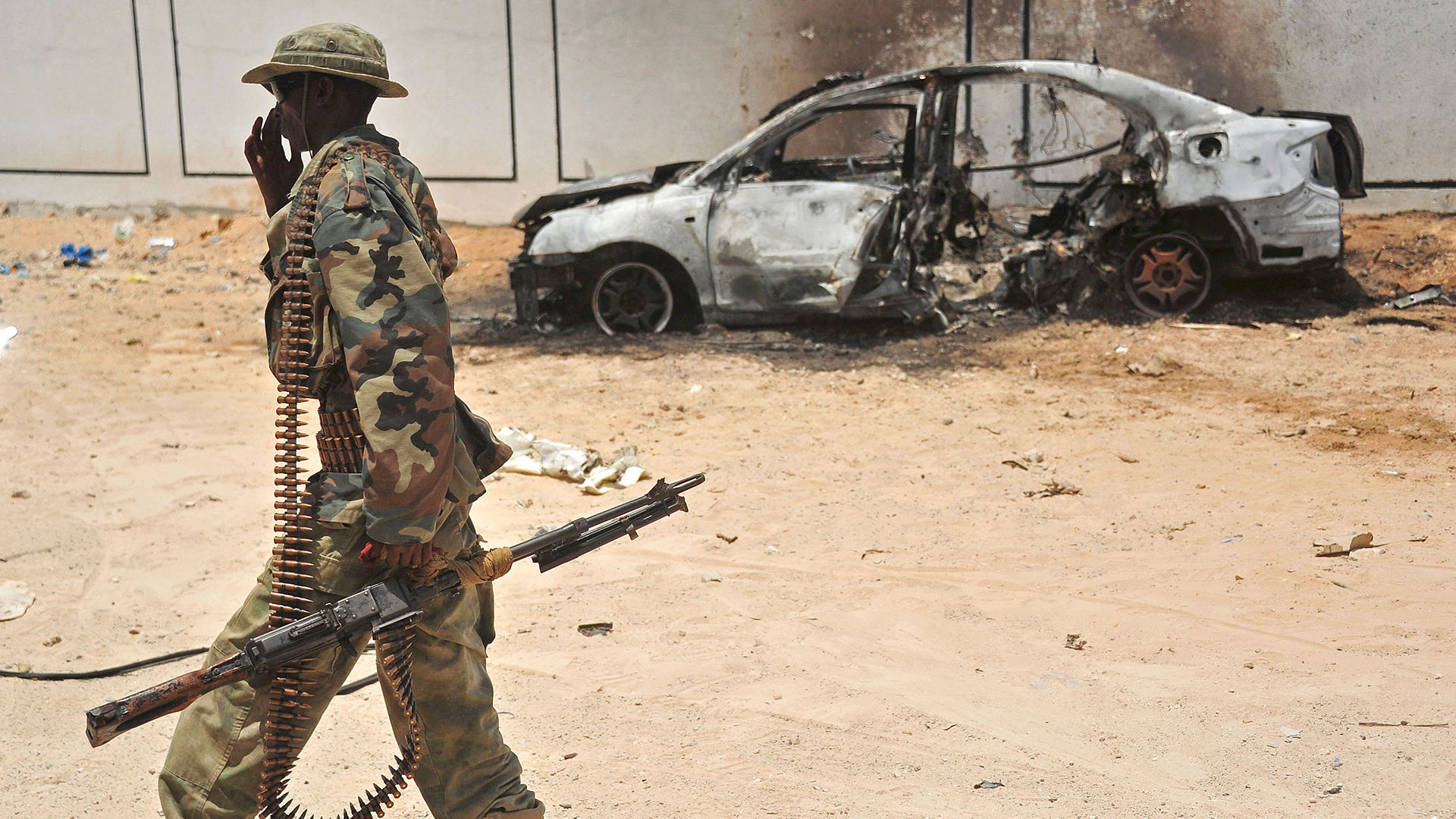

U.S. airstrikes in Somalia have recently killed 10 fighters with al-Shabab, a terrorist group that has pledged allegiance to al-Qaida, as a Somali government offensive has lost steam and African Union troops are expected to leave the country next year.
The U.S. military launched three airstrikes on July 8 and 9 to support Somali National Army forces that were battling al-Shabab fighters in Afmadow, about 293 miles south of Somalia’s capital of Mogadishu, according to U.S. Africa Command, or AFRICOM.
A total of 10 al-Shabab fighters were killed by all three airstrikes, AFRICOM spokeswoman Kelly Cahalan told Task & Purpose on Monday. No U.S. troops were on the ground at the time of the airstrikes, she said.
An initial assessment has determined that no civilians were killed in the airstrikes, an AFRICOM news release says.
“Somalia remains key to the security environment in East Africa,” the news release says. “U.S. Africa Command’s forces will continue training, advising, and equipping partner forces to give them the tools that they need to degrade al-Shabaab.”
Subscribe to Task & Purpose Today. Get the latest military news and culture in your inbox daily.
Al-Shabab has taken advantage of instability in Somalia to become al-Qaida’s largest, wealthiest, and deadliest offshoot, an NSC spokesperson told Task & Purpose. Not only has al-Shabab attacked U.S. troops in Somalia, but the group has killed more than a dozen American citizens in East Africa, including a soldier and two defense contractors during the Jan. 5, 2020 attack on U.S. troops at Manda Bay, Kenya.

The group also wants to attack targets in the West, said the NSC spokesperson, who noted that a suspected al-Shabab operative was arrested in 2019 after he attended flight school in the Philippines, where he allegedly was planning to hijack an aircraft for a 9/11-style attack.
U.S troops have been helping fight al-Shabaab since 2007. Most American service members left Somalia at the end of 2020 under former President Donald Trump. But In May 2022, President Joe Biden approved a Defense Department request to send several hundred troops back to Somalia.
Last September, the Somali government launched an offensive against al-Shabab that cleared the group out of central parts of the country, but al-Shabab has managed to regroup and hit back since then. Roughly 800 al-Shabab fighters attacked an African Union military base in Buulo Mareer, Somalia, in May, killing 54 Ugandan troops.
The U.S. military has launched 12 airstrikes in Somalia so far this year and conducted a special operations raid in January that killed ISIS leader Bilal-al-Sudani, said Caleb Weiss, an expert on jihadism in Africa and the Middle East.
Although the Somali government has stepped up operations against al-Shabab in the last couple days, its offensive has slowed since last year, said Weiss, a senior analyst with the Bridgeway Foundation, a nonprofit organization that seeks to end genocide.
Now al-Shabab is trying to take the initiative, Weiss told Task & Purpose on Monday.

That’s why al-Shabab launched its massive attack against the Ugandan base in Buulo Mareer, and why the group is targeting other bases that African Union forces have handed over to the Somalis, Weiss said.
The African Union Transition Mission in Somalia, or ATMIS is scheduled to complete its mission by the end of 2024. About 2,000 African Union troops left Somalia in June and another 3,000 are expected to depart by the end of September, Weiss said.
Political infighting among Somali government officials has delayed efforts to continue the offensive in the southern parts of the country, and the African Union withdrawal has provided al-Shabab with more targets of opportunity, Weiss said.
The Somali government is preparing for the eventual end of the ATMIS mission by asking Turkey, Qatar, and the United Arab Emirates to help train more Somali troops, he said.
“Whether or not those additional troops will actually be able to do anything, I don’t know,” Weiss said. “The AU [African Union] does provide force multipliers that, for the most part, these allies are not going to be able to do. No one is going to deploy that many troops to Somalia. So, it all depends on how well these additional troops will actually be able to withstand the inevitable al-Shabab major offensive once the AU actually leaves.”
The security situation in Somalia is in danger of deteriorating after the last African Union troops leave the country, said Jocelyn Trainer, an expert on the Horn of Africa with the Center for a New American Security think tank in Washington, D.C.
Even with African Union forces in Somalia the country’s security situation has ebbed and flowed, with 2022 marking the deadliest year in Somalia since 2018, Trainer told Task & Purpose. Al-Shabab has consistently shown that it can adopt new tactics, such as using improvised explosive devices, and either win support from civilians or force them to submit.
“Somali security forces also face a growing presence of the Islamic State in Mogadishu, increasingly active clan militias—that have fluid loyalties—and tensions with Somaliland in addition to increased violence from al-Shabaab. The Horn is also becoming increasingly unstable at large, potentially contributing to increased tensions with neighbors, such as Ethiopia, and reduced resources and political will to enhance the security situation in Somalia. These factors contribute to an increasingly difficult security situation for the nascent Somali Army to tame.”
The latest on Task & Purpose
- We salute the USS Chung-Hoon for flying its battle flag on the way back to port
- The New Yorker makes a joke of the Army’s tactical bra. It’s not
- The Army’s yearslong fight over its controversial new fitness test isn’t over yet
- Army names finalists in race to replace M2 Bradley Fighting Vehicle
The A-10 is retiring and the Air Force has no close air support replacement